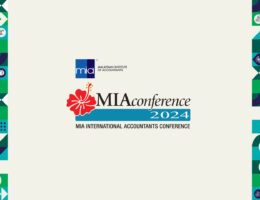By Nithea Nadarajah
Tan Liong Tong is no stranger to Malaysian accountants, with his technical accountancy books flying off the shelves.
The accounting guru and prolific author is renowned for his significant contributions to the corpus of Malaysian accounting literature. His works include, amongst others, his books on Consolidated Financial Statements, Financial Accounting and Reporting in Malaysia, Deferred Taxation and the Illustrative MPERS Financial Statements, editions one and two. The Illustrative MPERS Financial Statements were a joint effort with the MIA’s technical team, aimed to help MIA members on the application of the MPERS Reporting Framework for private entities in Malaysia. A retired university lecturer since 2006, Tan is still actively authoring books and online publications, teaching part-time, providing consultancy services as well as getting involved in technical development projects.
Academic and Author
Tan’s journey began ordinarily enough in 1977 when he was gainfully employed as a tutor and in 1979 as university lecturer of agribusiness. But by a quirk of fate, he was seconded to an established accounting firm to undertake his professional accounting exams. Three years later, in 1986, he completed his articleship with the accounting firm and returned to the university to resume teaching, but as an accounting lecturer.

Once an academic, always an academic. “I love teaching,” enthused Tan. So intense was his enthusiasm for teaching combined with his passion for the accountancy profession that early on in his career he became actively involved with the Malaysian Institute of Certified Public Accountants (MICPA) and MIA technical committees, during the time when local standards were being developed. “It’s not just about teaching, we’ve got to keep ourselves up-to-date with the changes and developments,” said Tan.
A prerequisite for any academician is to teach, to research and to extend his professional development, which includes the publication of written articles. Naturally, publishing a book became one of Tan’s dearest ambitions and he fulfilled this dream when he released his first book on financial management.
His second book, however, had a greater purpose. Owing to the lack of reference books for MICPA students sitting for their final exams, Tan compiled his lecture notes into his second book, Consolidated Financial Statements. This book, released in the early 1990s, proved to be a game changer. Although initially authored for final year accounting students, it became increasingly popular amongst accounting practitioners and preparers.
This unexpected endorsement spurred him on and motivated him to persevere as an author. In 2018 alone, he produced three books, the latest of which is A Comprehensive Guide to IFRS 15 and 16. Two more books are scheduled for release sometime this year, with another publication due in the year 2020. “Satisfaction is seeing your book in the bookshop. Monetary reward is secondary,” explained Tan.
How to Write a Book
Asked about the end to end process of writing a book, Tan explained that prior to the commencement of writing, it is imperative to identify the target audience to ensure appropriateness of content. Next, undertake proper planning of the subject matter from A to Z. “Always start-off writing the article in a logical manner and state the rationale and principle involved in a particular area,” said Tan. If it’s an accounting-related publication, examples and illustrations are imperative to ensure that readers can better grasp the information. Set a reasonable timeline for completion; Tan advised potential writers to never halt writing midway or risk losing momentum.
During the event, Tan also shared his views on current developments in the profession.
Judicious Disclosure
Tan advised companies to practice discretion with regards to full disclosure. With the advent of accounting standards issued since the 1970s along with the many companies taken public, stringent reporting requirements have become the norm. Naturally, the quantum of information disclosed in the financial reports grew steadily in tandem. “Previously, there was an abridged version of the profit and loss account but now, it is full disclosure,” observed Tan.
While investors and potential investors would most certainly benefit from increased transparency, providing too much information would be overwhelming. His advice would be to fall back on the basic principles of materiality and to apply sound judgement during the preparation of financial reports.
Public Sector Reporting
Historically, the Malaysian public sector practised modified cash accounting (with non-capitalisation of assets and non-reporting of liabilities). However, with effect from 1 January 2018, under the Malaysian Public Sector Accounting Standard (MPSAS) framework, the federal and state governments have commenced their transition to accrual accounting.
Nonetheless, Tan said that it may prove to be inappropriate and quite arduous to endorse full accrual accounting for certain government agencies. One barrier is fair value. For example, when public universities receive land donations from the state governments for use as capital or plantations, “the main concern would be on how to fair value the land received.” Fair value accounting is an area which Tan feels still warrants extensive research.
Tan concluded his comments by advising accountants to fearlessly embrace and adapt to technological changes and to always uphold their integrity and professional code of ethics.
Watch the video on the session.








